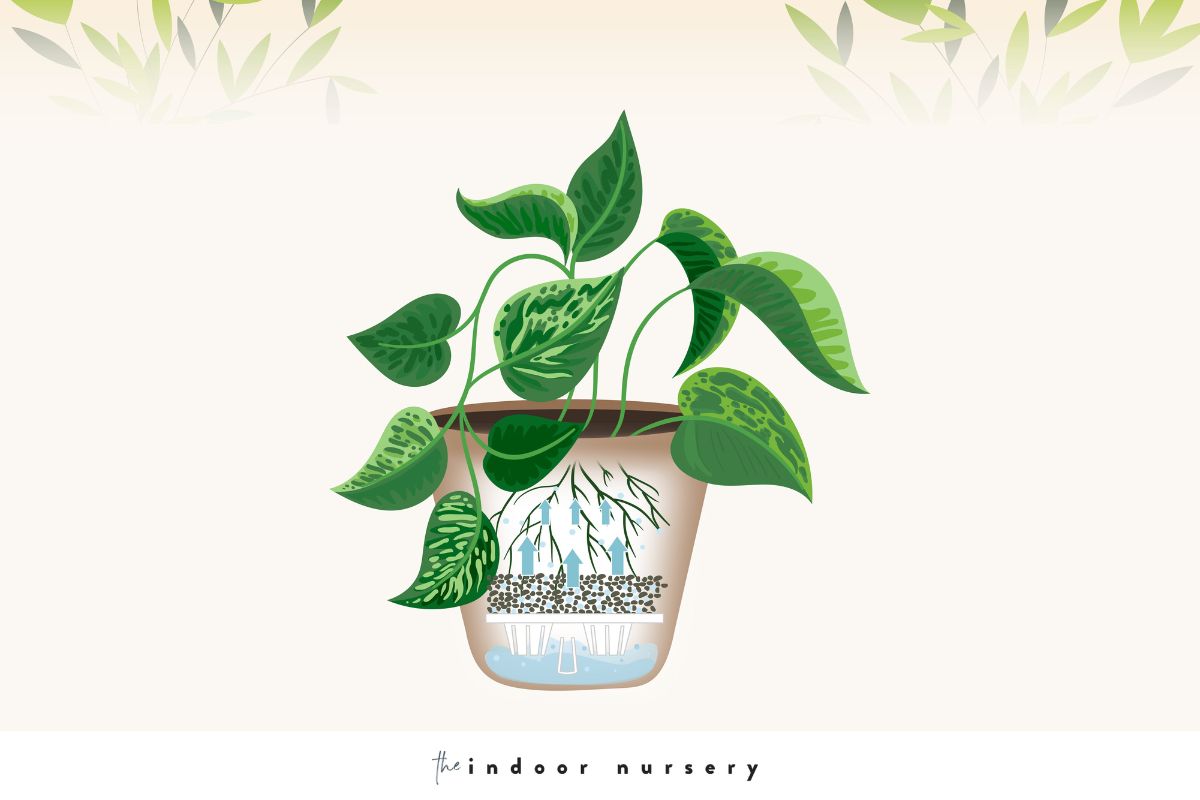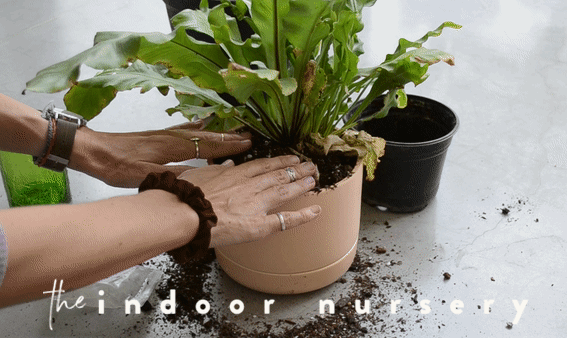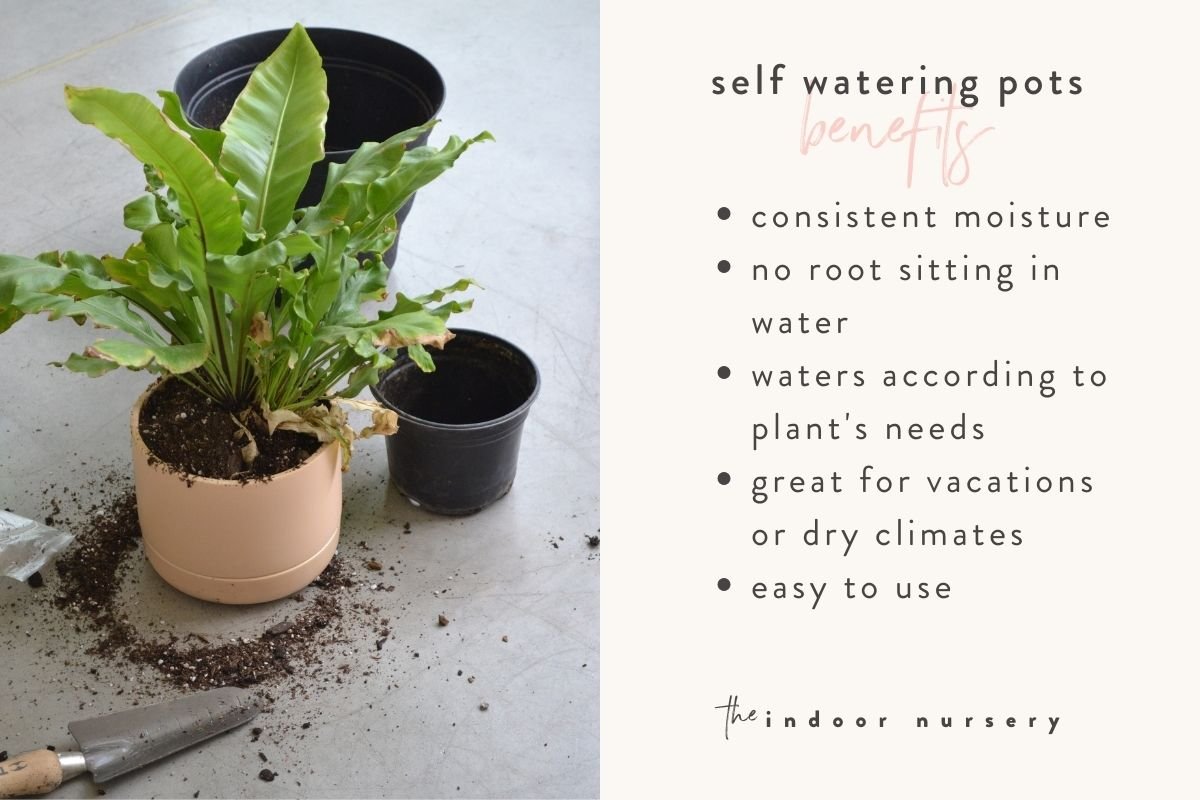One of the hardest parts about having indoor plants, for me, is that I travel a lot. I love growing plants right inside my home, but every month or so I travel for a few weeks and all of my houseplants take a major beating.
I’ve tried a few different self watering methods, like watering globes, wine bottles, self-watering moss poles, and clay self watering spikes to keep the soil moist while I’m away.
But honestly, those methods fell short.
Watering globes drained straight through the pot and self watering spikes are really best for shorter trips for less than 2 weeks. Self-watering moss poles actually require a lot of watering on my part.
What I like about a self watering planter is that the water reservoir design allows the plant roots to take what they need from the reservoir and only when they need it.
So before my next trip, I decided to try out Greenery Unlimited’s self watering pot to see if it could make traveling a little easier.
Here’s how how to use a self watering pot, featuring Greenery Unlimited!
How self-watering pots work
Self-watering pots typically have a water reservoir that is connected to the potting soil via a wicking system. The wicking system consists of a porous material, such as clay pebbles in my case, that transports water from the reservoir to the potting soil. This allows the potted plant to receive a consistent supply of water, which reduces the need for frequent watering.
Other materials that can be used are cotton string or rope, sphagnum moss, or anything else that retains water.

How to use a self watering pot, step-by-step
Place the plastic basket in the hole of the pot. I placed the pot on top of the empty reservoir so that the basket didn’t push up into the clay pebbles.

Add clay pebbles.

Add fresh potting soil. I love using Fox Farm.
Remove the potted plant from its original container and tease out some of the roots.
Drop it into the new pot and fill remaining gaps with fresh potting soil.

Lift the pot and fill the water reservoir with fresh filtered water. I kept the water level just below the top of the ceramic plate to accommodate the bottom of the pot when I placed it on top of the water.

How to maintain a self watering plant pot
- fertilizing – you can add liquid fertilizer to the water, following the manufacturer instructions.
- root pruning – when the roots begin to outgrow the space, you can trim the smaller thread plant roots to make space; Greenery Unlimited says to never cut away more than 1/3 of the of the root mass when pruning.
- root flushing – if you choose to fertilizer your plant, then Greenery Unlimited recommends running the potted plant under gently running water for 10-20 minutes.

Greenery Unlimited self watering pot review
Greenery Unlimited offered to send us a pot to check out and write about. Of course, I accepted. I’ve been searching for something like this on Amazon for ages but haven’t really found any designs I liked.
I love the GU designs, they’re exactly what I was looking for but couldn’t find easily.
I received the Franklin 17 in pale salmon.

As for the package, it arrived easily and well protected. The instructions were right on the side of the box, saving on waste and making the entire process insanely easy.
I love the QR code on the box, it leads you to this instructional video.

I placed my fern into this pot because it is the plant that suffers the most when we’re away. We just returned (at 2 a.m.!) last night and I was in such a panic over the gray, lifeless little memory of a fern that I walked in on that I sat it in a dish of filtered water immediately. I forgot to take a “before” picture, but it has been looking much happier ever since.
Since my fern quickly perks up any time I water it from the bottom, I’m guessing that it will be very happy in its new home.
When I return from my next trip, I’ll show the health of the plant when using this self watering pot.
PRO TIP: These make great gifts for plant lovers 😉
Common questions
How often do you fill self watering pots?
This really depends on the climate where you live, the potting soil you use, the season, and what kind of plant you have. Keep an eye on the water level over time and when the reservoir becomes empty, allow the plant roots to dry out for a few days.
Do self watering pots cause root rot?
Most self watering containers are safe for your plants. When designed and maintained properly, your roots won’t be sitting in excess water, which is what causes root rot. This is why it’s important to allow your plant roots to dry out for a few days in between watering.
If root rot does begin to appear, then trim away the dead roots and rinse with filtered water. Then allow the roots to dry out for a few days.
Do self-watering pots need drainage?
The drainage hole at the bottom of the self watering container allows moisture to wick upward into the soil, not the other way around. Because you won’t be watering your plants from the top, water will never need to drain from the soil. Nonetheless, the drainage hole at the bottom will provide all the drainage it needs.
What plants do well in self watering pots?
– pothos
– ferns
– herbs
– swiss cheese plants
Do succulents like self watering pots?
Succulents are desert plants, so they retain water in their squishy leaves and have fine roots that can reach through the rocky desert ground for hidden water. Naturally, they don’t do well when sitting in water. However, that isn’t to say that succulents don’t love a lot of water. In fact, they do. I find my succulents happiest when they are outside during the rainy season. My indoor succulents are much slower to grow and smaller, mostly because I don’t water them nearly as often. That’s how their leaves become so fleshy!
More about watering plants
- How Often To Water Dracaena (Including Snake Plants)
- How to Use Leca for Plants: Step-by-Step Guide with Pictures
- How To Save An Overwatered Snake Plant
- How Often To Water Pothos Plants (And When To Cut Back)
- How Often To Water Monstera Plants
- 11 Plants That Don’t Need Drainage And How To Care For Them
- Save Your Overwatered Monstera In 4 Steps (And How Not To Do It Again)
